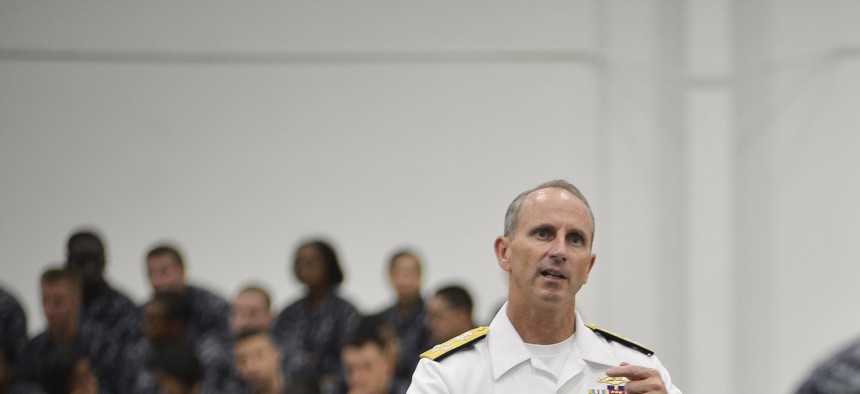
Chief of Naval Operations Adm. Jonathan Greenert speaks to more than 3,700 Sailors during an all-hands call with students and staff at Naval Education and Training Command. U.S. Navy photo by Mass Communication Specialist 1st Class Peter D. Lawlor
What the US Navy of the Future Looks Like
Chief of Naval Operations Adm. Jonathan Greenert previews the Navy's new course in increasingly hostile international waters. By Janine Davidson and Sam Ehrlich
Admiral Jonathan W. Greenert, Chief of Naval Operations,visited the Brookings Institution earlier this month to discuss future Navy strategy. Greenert, who has held the position of CNO for three years, touched on issues pertaining to Asia and the Pacific, sequestration, U.S. Naval arms and technology developments, and strategy for Navy’s assured access around the world. Greenert remained hopeful that the official Maritime Strategy would be decided by the end of this calendar year, and his remarks offered a preview as to what that strategy might include.
The importance of the Asia-Pacific is a major focus in the Navy’s upcoming strategy. Greenert pointed out that much of U.S. and global shipping passes through this region—especially oil. He added that many of America’s trading partners are also located here, and that U.S. treaties with many allies are predicated on a strong Asia-Pacific presence. This observation echoes recent comments by Deputy Secretary of Defense Bob Work at the Council on Foreign Relations last month.
U.S. naval presence will be increased in Asia through forward deployment. According to Greenert, 60 percent of Naval forces will be rebalanced to the region by 2020(from a roughly 50/50 split currently). Much of the fleet will be “homeported” in the Pacific, to areas such as Guam and Singapore, where many ships are currently ported on a rotating basis.
Responding to how U.S. naval strategy will navigate relations with China, noted mutual prosperity is in both countries’ best interests. The Admiral stressed the necessity to set specific protocol for encounters at sea and the importance of dialogue between the two countries. This past August, the Code for Unplanned Encounters at Sea (CUES), was passed by both China and the U.S.—however, it is not legally binding. Therefore, Greenert plans to continue regular conversations with China’s Admiral Wu Shengli, which will cover crucial topics pertaining to international laws and rules of behavior. Greenert was adamant that there needs to be protocol between nations at sea to avoid miscalculations, which he says can put countries in dangerous situations. Likewise, the new four-star commander of Air Forces in the Pacific, General Lori Robinson, is emphasizing the same with respect to airpower in the region and initiating a dialogue with China on air safety.
With China’s expanding Navy and its technological advancements, some have worried that the U.S. might not be doing enough to keep up. In addition, there are concerns that sequestration could further limit the Navy’s presence. Greenert commented that while sequestration could likely mean finances will need to be reallocated, currently the Navy is still on plan for shipbuilding through 2025.
Under the current budget, Greenert says the objective is to have 308 ships by 2020 and 317 ships by 2025. However, if the Navy is forced to reallocate funds. Greenert believes that the Navy’s shipbuilding account would be most affected. He says it is likely that one or two shipbuilders—out of the U.S. Navy’s five remaining—would be shut down. This would also affect mid-grade venders that manufacture valves and circuits necessary for ships and especially important for nuclear ships.
Advances in weapon technology must also be assessed in the Navy’s strategic outlook. Greenert spoke about directed energy and the Navy’s Laser Weapon System (LaWS), which will be tested again in just a few days. This could be a major advancement in weapons technology and Navy combat strategy if they are able to increase the amount of energy that LaWS can power.
The advantages of LaWS could help the Navy immensely, especially in cost. Greenert estimated the cost of firing the LaWS system at $1 per fire, whereas “bullet to bullet warfare” can generate fully burdened costs of roughly $1 million to fire a missile.
In his ending remarks, Greenert touched on the Navy’s strategy when assessing assured access in areas of the sea. The three steps he laid out in planning for naval action were:
- Assess areas in which Navy has opposed access.
- Determine whether the necessary action is “kinetic” or “non-kinetic.”
- Consider options for the Navy to achieve access (undersea, sea-surface, air, or perhaps in combination).
It will be interesting to see Greenert statements are incorporated into the new Maritime Strategy, which should be released in the upcoming months. The emergence of new global threats and challenges has required the U.S. Navy, in coordination with the Marine Corps and Coast Guard, to update it 2007 Maritime Strategy to tackle these obstacles and issues. Let’s hope the new document retains the elegance of the previous version, and focuses on the enduring strategic role of maritime forces.
Finally, despite all going on in the world, perhaps the greatest challenge to the new Maritime Strategy will lie with Congress and the specter of budgetary sequestration. Budgets and strategy are inextricably linked—the best strategy in the world will have only limited effect without the smart financial planning to back it up.
This post appears courtesy of CFR.org.
NEXT STORY: DOD To Spend Billions More on Nukes




